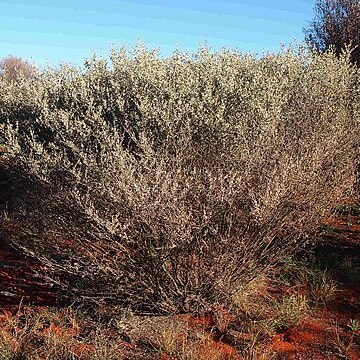Rounded or obconic, multi-stemmed shrubs or sometimes trees 1–4 (–5) m tall and about the same in diameter; crowns compact and often grey or bluish grey. Branchlet ribs with a thick, normally opaque (rarely translucent) covering of resin that often persists to mature branchlets as beaded, white lines. New shoots enveloped by a conspicuous layer of resin when young, the resin opaque and whitish grey tinged bluish or translucent and brown. Phyllodes flat, straight and dimidiate to shallowly recurved or shallowly sigmoid, elliptic to oblong-elliptic or oblong-obovate, 5–25 (–30) mm long, (1.5–) 2–4 (–5) mm wide, mucronulate, grey to grey-green, sub-glaucous or glaucous, longitudinal nerves numerous and prominent. Inflorescences single in axils; peduncles 4–12 mm long; spikes 8–15 (–20) mm long. Flowers 5-merous; sepals ±free; corolla 1.4–1.5 mm long, glabrous. Pods shortly stipitate, oblong, flat, mostly 1.5–3.5 cm long, 8–15 mm wide, including wing 1–2 mm wide, chartaceous, brown, reticulately nerved, ±glabrous, dehiscent. Seeds oblique to transverse, oblong, 4.5–6 mm long, 2.5–3.5 mm wide; aril small, terminal, oblique, pileate, creamy.
More
A shrub. It grows 3 m tall. It has several stems. It is covered with resin. The leaves are small and narrowly oval. The phyllodes are oblong to narrowly oval and 5-25 mm long by 2-4 mm wide. The flowers are yellow. The pods are oblong and flat. They are 15-35 mm long by 8-16 mm wide. They have wings 1-2 mm wide.
Usually found on sandy soils, occasionally on loamy clays, particularly in dune swales and occasionally on shallow rocky soils.
More
Usually grows in sandy soils, particularly in dune swales and occasionally in shallow rocky soils.
It is a subtropical plant.
Can be grown by seedlings. Seeds needs soaking.


